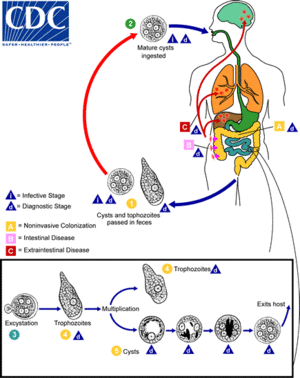User:Doc James/Amoebiasis
| Amoebiasis | |
|---|---|
| Other names | Amoebic dysentery, amebiasis, entamoebiasis |
 | |
| The life-cycle of various intestinal Entamoeba species | |
| Medical specialty | Infectious disease |
| Symptoms | Bloody diarrhea, abdominal pain[1] |
| Complications | Severe colitis, colonic perforation, anemia[1] |
| Causes | Amoebas of the Entamoeba group[1] |
| Diagnostic method | Stool examination, antibodies in the blood[1] |
| Differential diagnosis | Bacterial colitis[1] |
| Prevention | Improved sanitation[1] |
| Treatment | Tissue disease: metronidazole, tinidazole, nitazoxanide, dehydroemetine, chloroquine, Intestinal infection: diloxanide furoate, iodoquinoline[1] |
| Frequency | ~480 million[1] |
Amoebiasis, also known amoebic dysentery, is an infection caused by any of the amoebae of the Entamoeba group.[1] Symptoms are most common during infection by Entamoeba histolytica.[1] Amoebiasis can be present with no, mild, or severe symptoms.[1] Symptoms may include abdominal pain, diarrhea, or bloody diarrhea.[1] Complications can include inflammation and ulceration of the colon with tissue death or perforation, which may result in peritonitis.[1] People affected may develop anemia due to loss of blood.[1]
Cysts of Entamoeba can survive for up to a month in soil or for up to 45 minutes under fingernails.[1] Invasion of the intestinal lining results in bloody diarrhea.[1] If the parasite reaches the bloodstream it can spread through the body, most frequently ending up in the liver where it can cause amoebic liver abscesses.[1] Liver abscesses can occur without previous diarrhea.[1] Diagnosis is typical by stool examination using a microscope, but may not reliably exclude infection or separate between specific types.[1] An increased white blood cell count may be present in severe cases.[1] The most accurate test is finding specific antibodies in the blood, but it may remain positive following treatment.[1] Bacterial colitis can result in similar symptoms.[1]
Prevention of amoebiasis is by improved sanitation, including separating food and water from faeces.[1] There is no vaccine.[1] There are two treatment options depending on the location of the infection.[1] Amoebiasis in tissues is treated with either metronidazole, tinidazole, nitazoxanide, dehydroemetine or chloroquine, while luminal infection is treated with diloxanide furoate or iodoquinoline.[1] Effective treatment against all stages of the disease may require a combination of medications.[1] Infections without symptoms do not require treatment but infected individuals can spread the parasite to others and treatment can be considered.[1] Treatment of other Entamoeba infections apart from E. histolytica is not needed.[1]
Amoebiasis is present all over the world,[2] though most cases occur in the developing world.[3] About 480 million people are currently infected with about 40 million new cases per year with significant symptoms.[1] This results in the death of between 40,000–110,000 people a year.[1] Most infections are now believed due to E. dispar.[1] E. dispar is more common in certain areas and symptomatic cases may be less common than previously reported.[1] The first case of amoebiasis was documented in 1875 and in 1891 the disease was described in detail, resulting in the terms amoebic dysentery and amoebic liver abscess.[1] Further evidence from the Philippines in 1913 found that upon swallowing cysts of E. histolytica volunteers developed the disease.
- ↑ 1.00 1.01 1.02 1.03 1.04 1.05 1.06 1.07 1.08 1.09 1.10 1.11 1.12 1.13 1.14 1.15 1.16 1.17 1.18 1.19 1.20 1.21 1.22 1.23 1.24 1.25 1.26 1.27 1.28 1.29 1.30 1.31 1.32 1.33 Cite error: The named reference
Mansons2013was used but no text was provided for refs named (see the help page). - ↑ Beeching, Nick; Gill, Geoff (2014-04-17). "19". Lecture Notes: Tropical Medicine. John Wiley & Sons. pp. 177–182. ISBN 9781118734568.
- ↑ Shirley DT, Farr L, Watanabe K, Moonah S (July 2018). "A Review of the Global Burden, New Diagnostics, and Current Therapeutics for Amebiasis". Open Forum Infectious Diseases. 5 (7): ofy161. doi:10.1093/ofid/ofy161. PMC 6055529. PMID 30046644.